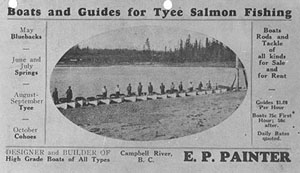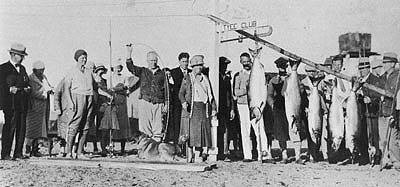 |
Glossary |
| |
 |
Fishing Techniques |
|
The Tyee Club

A model of the 70lbs Tyee that Sir
Richard
Musgrave caught at Campbell River, 1896.
© Campbell River Museum Archives Image #16986
"Tyee" is another name given to the Spring or Chinook salmon, the largest of all the salmon
species. The name "Tyee" comes from an Indian word that means "great" or "chief." The term
Tyee is usually used to refer to Spring or Chinook salmon that weigh 30lbs or more. Campbell
River, in British Columbia, is known as the salmon and Tyee capital of the world. It was here
that the famous Tyee Club was born.
The idea for the Tyee Club was thought up by Dr. J. A. Wilborn, Mr. A. N. Wolverton, and
Mr. Melville Haig (the manager of the Willow Hotel in Campbell River) in 1924. These three
men were socializing at the Willows Hotel when they decided that the Tyee salmon was just as
great as the California Tuna, and hence, the Tyee deserved a club that would protect and honor it.
The Tyee club officially started in 1925 with the setting up of a set of rules.
Sports fishing advertisement for
Painter's Lodge Campbell River. © Campbell River Museum Archives Image
#6029
 |
One important member, who was instrumental in the success of the Club and Tyee fishing in
general, was E.P. Painter. He owned one of the first fishing camps, located on the Spit, which
later grew into a resort lodge. He was also the inventor and manufacturer of the Tyee boat. This wooden rowboat, and its modern fiberglass descendent, would become the boat predominantly used by
Tyee fishermen. E.P Painter provided the accommodations and the boats for Tyee fishing guides
and their guests. This helped attract fishermen from around the world to Campbell River and led
to the flourishing of the Tyee Club.
Two of the aims of the club were to increase interest in game fishing of the Tyee and to
emphasize the principles of sportsmanship. The club accomplished both of these aims. Today,
Tyee fishing and the Tyee Club are world renown. People from all over the world come to
Campbell River in August to try to catch one of the great Tyees, or earn a place in the Tyee Club
hall of fame. Moreover, the club, with its strict rules on how the Tyee is caught, has made
catching one an art and a challenge. It is not the number of fish you catch but rather the size and
the fight that count. Because it is not easy to catch a Tyee according to club rules, the number of
Tyee caught each year is less than the number of salmon caught by other means.

People gathered on beach to weigh Mrs. Weeks'
salmon.
© Campbell River Museum Archives Image #6018
To become a member of the Tyee Club, you have to pay a registration fee, then catch a
salmon that weighs 30 pounds or more. Once you catch a Tyee, a button is awarded to you
according to how much your Tyee weighs. There are rules and regulations to follow if one wants
to be a member of the Tyee Club - most of them have changed little to date. Some are as follows:
- Fishers must have a current fishing license.
- The fish has to be caught in a specific area (Tyee pools)
- The boat being used cannot be powered by a motor, except to get to the fishing grounds.
Otherwise the boat must be oar powered.
- A fishing rod must be between six and nine feet long (2-3m).
- The reel must be hand operated with no clutch mechanisms.
- The fishing line must have a breaking point of 20 lbs. (9kg).
- Artificial lures that are made for trolling must be used.
- Hooks with only one barb on them must be used.
In addition to the above rules, the Tyee Club must also check a person's equipment before
setting out, in order for him/her to qualify for club awards.
Ray E. Slocum holding his 1947
Tyee Man of the Year 70 1/2lbs catch.
© Campbell River Museum Archives
Image #9993
 |
Once you catch a Tyee, a button is awarded to you according to how much your Tyee
weighs: bronze button (30-40lbs), silver (40-50lbs) and gold (50lbs or bigger). The current Tyee
record holder is Walter Shutts of Oregon who caught a 71 lbs. Tyee in 1968. However, larger
Tyees have been caught that are not recorded in the Tyee Club records. For instance, John Saxer
caught a 77lbs Tyee in 1966, and in 1955 the largest sea catch was caught in Rivers Inlet,
weighing 82 lbs. However, these larger Tyees were not caught according to the philosophy of
the Tyee Club.
Both Roderick Haig-Brown and Van Egan, quoted below, have summed up the true nature of
Tyee fishing.
"Fishermen who come to Campbell River in search of the Tyee salmon are of one of two
breeds. There are those whose first priority is just to catch one of these great Chinooks of 30-lb
or more, by whatever means is necessary; and there are those who want one of these huge fish,
but want it on terms that require of them the careful attention and skillful handling of a master
angler. The latter are the men and women who follow the code of
the Tyee Club of British Columbia."
"World class angling clubs...have in common a philosophy that recognizes the greater sense
of achievement from catching a large fish under conditions that raise the skill-level of the angler... Though materials in the manufacture of rods, lines and boats
have changed over the years, and any number of modern technologies have been devised to give
fishermen a decisive advantage over the fish, the Tyee Club has stayed with its tradition, making
skillful angling the essence of the sport." (Van Egan. River
Sportsman.)
Campbell River is the home of the Tyee Club and new members are always welcome, no
matter how old you are or where you are from. All you need is a rowboat and a desire to catch
the Tyee.
Top of page.
|



